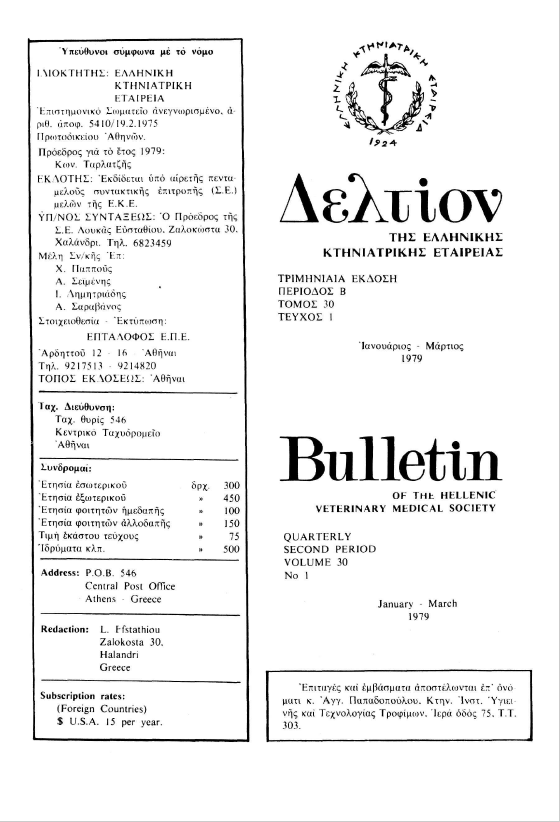Adjuvant activity of saponin and its fractions in foot and mouth disease vaccine
Abstract
An assay was made to separate the adjuvant factor of saponin from the hemolytic using the chromatography method. A 40% saponin solution was passed through Sephadex G-25 column and the first fraction was passed again through Sephadex G-200 column. 2 out of 3 peaks obtained through Sephadex G-200 column were examined. These two peaks were compared with those obtained with Foodand -Mouth Disease vaccine containing a 40% saponin solution and concerning the capacity for hemolysis, necrosis and adjuvant effect of this vaccine. The 40% sapnonin solution gives hemolysis of sheep red cells (3% red cells washed and diluted in veronal buffer) when the quantity of saponin is at least 0,078 mg in the solution. The fraction A and Β obtained through G-25 column give hemolysis when the quantities of saponin are 0,156mg and 0,312mg respectively. The fraction II obtained through G-200 column gives hemolysis with 0,156mg while the fraction I does not give hemolysis even with a 10-fold quantity of saponin. The hemolysis was compared using a 3% suspension of sheep red cells and blood agar (1% agar with 3% sheep red cells). The hemolytic titre of saponin in blood agar Is 3 dilutions higher (with dilution logarithm 2) from the one on the suspension of red cells. This led us to think of using this method for detecting smaile quantities of saponin. The irritation and necrosis degree are different when saponin as a whole and its fraction are used. A 40% saponin solution containing 0,8mg of this substance gives 50% necrosis. To obtain the same degree of necrosis we need 3, 4mg and 1,13mg of saponin when fractions A and Β through G-25 are respectively used. When the fraction II through G-200 is used 3mg of saponin are needed, while the fraction I through the same column does not give any necrosis even used in 10-fold volume. Neutralizing antibodies titres in guinea pigs after vaccination and infection with the same Foot and-Mouth Disease virus subtype (A22) are fluctuating and do not correlate with the protection obtained in these animals. The PD! 0 in guinea pigs injected with a Food-and-Mouth disease vaccine (subtype A22) witout addition of saponin is 0,125 mg of vaccine. Adding in this vaccine a 40% saponin solution (that is 0,312mg of saponin per vaccine dose) the PD,0 in guinea pigs is 0,062. Using a lower saponin dilution (that is 0,625 mg per vaccine dose) the PDJ 0 in guinea pigs is 0,031ml of vaccine. The addition of fraction I and II though Sephadex G-200 does not have any influenc on the immunizing capacity of the vaccine
Article Details
- How to Cite
-
ΔΗΜΗΤΡΙΑΔΗΣ I. A. (2019). Adjuvant activity of saponin and its fractions in foot and mouth disease vaccine. Journal of the Hellenic Veterinary Medical Society, 30(1), 83–95. https://doi.org/10.12681/jhvms.21384
- Issue
- Vol. 30 No. 1 (1979)
- Section
- Articles

This work is licensed under a Creative Commons Attribution-NonCommercial 4.0 International License.
Authors who publish with this journal agree to the following terms:
· Authors retain copyright and grant the journal right of first publication with the work simultaneously licensed under a Creative Commons Attribution Non-Commercial License that allows others to share the work with an acknowledgement of the work's authorship and initial publication in this journal.
· Authors are able to enter into separate, additional contractual arrangements for the non-exclusive distribution of the journal's published version of the work (e.g. post it to an institutional repository or publish it in a book), with an acknowledgement of its initial publication in this journal.
· Authors are permitted and encouraged to post their work online (preferably in institutional repositories or on their website) prior to and during the submission process, as it can lead to productive exchanges, as well as earlier and greater citation of published work.



